Impact of Organizational Culture on WHS Processes
VerifiedAdded on 2020/07/22
|8
|2482
|86
AI Summary
This assignment delves into the critical role of organizational culture in implementing effective workplace health and safety (WHS) processes. It emphasizes the importance of creating a safe and secure environment for employees by treating them as part of the administration and ensuring that all workplace safety needs are met. Moreover, it highlights the benefits of using a WHS management information system, including reducing injuries and associated costs, meeting legal requirements, and gaining business opportunities.
Contribute Materials
Your contribution can guide someone’s learning journey. Share your
documents today.
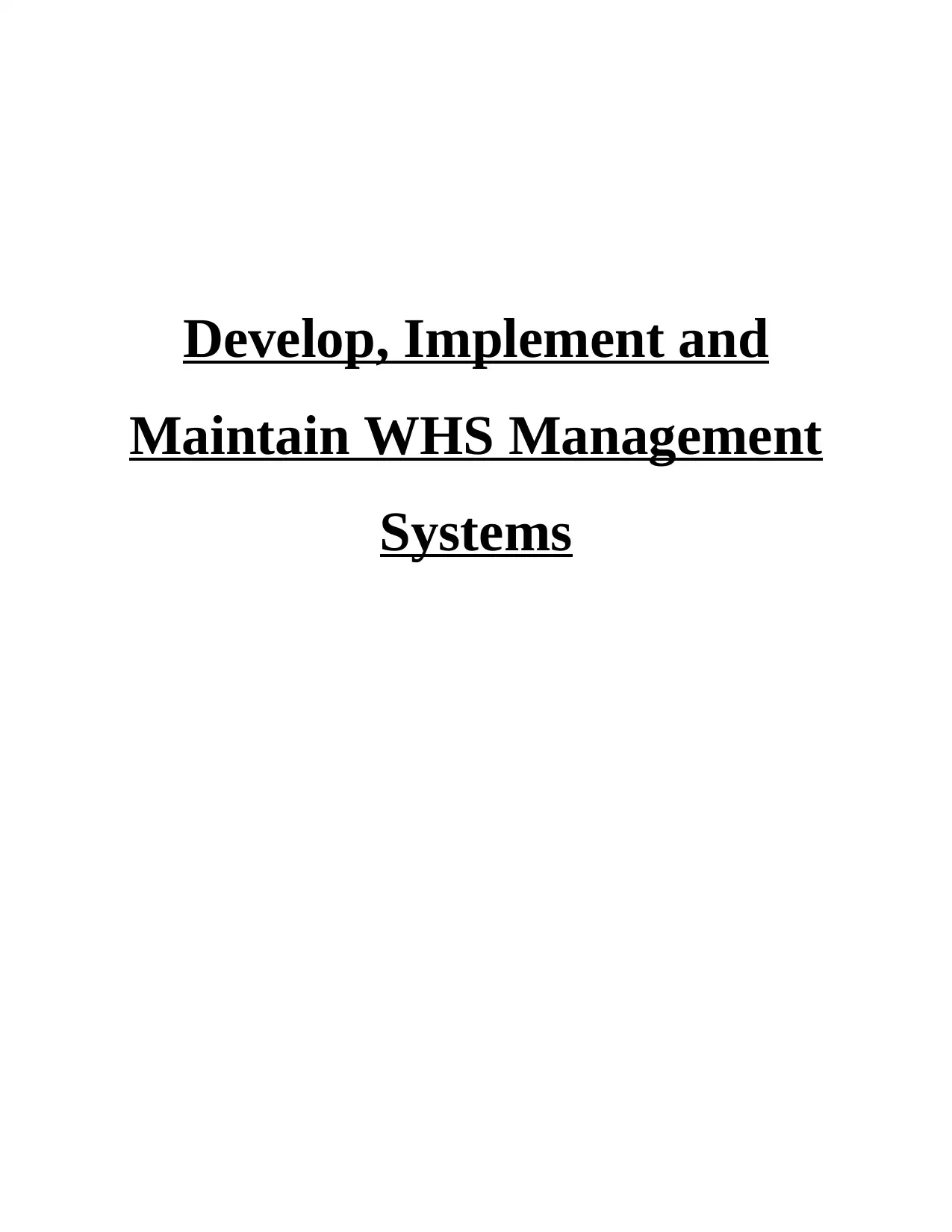
Develop, Implement and
Maintain WHS Management
Systems
Maintain WHS Management
Systems
Secure Best Marks with AI Grader
Need help grading? Try our AI Grader for instant feedback on your assignments.
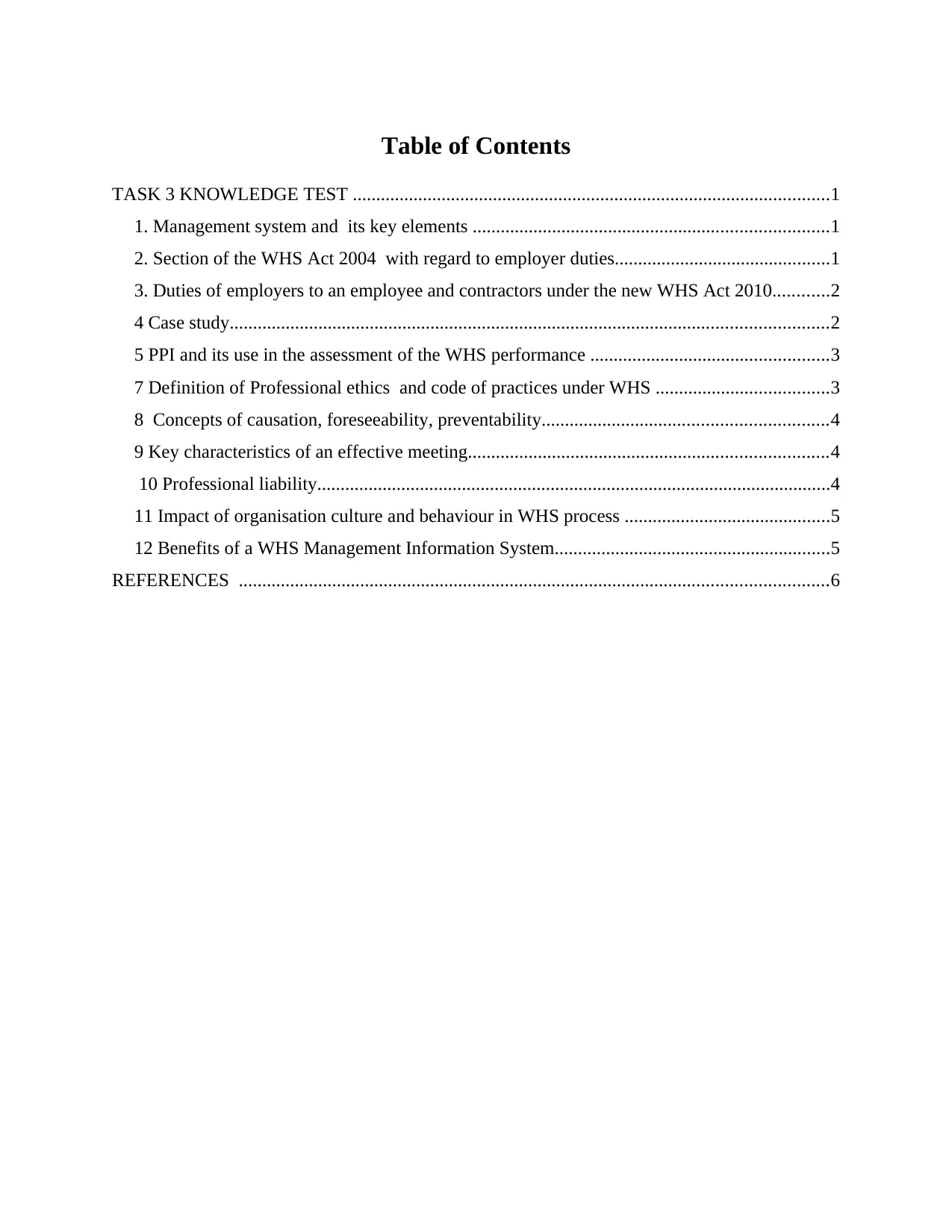
Table of Contents
TASK 3 KNOWLEDGE TEST ......................................................................................................1
1. Management system and its key elements ............................................................................1
2. Section of the WHS Act 2004 with regard to employer duties..............................................1
3. Duties of employers to an employee and contractors under the new WHS Act 2010............2
4 Case study................................................................................................................................2
5 PPI and its use in the assessment of the WHS performance ...................................................3
7 Definition of Professional ethics and code of practices under WHS .....................................3
8 Concepts of causation, foreseeability, preventability.............................................................4
9 Key characteristics of an effective meeting.............................................................................4
10 Professional liability..............................................................................................................4
11 Impact of organisation culture and behaviour in WHS process ............................................5
12 Benefits of a WHS Management Information System...........................................................5
REFERENCES ..............................................................................................................................6
TASK 3 KNOWLEDGE TEST ......................................................................................................1
1. Management system and its key elements ............................................................................1
2. Section of the WHS Act 2004 with regard to employer duties..............................................1
3. Duties of employers to an employee and contractors under the new WHS Act 2010............2
4 Case study................................................................................................................................2
5 PPI and its use in the assessment of the WHS performance ...................................................3
7 Definition of Professional ethics and code of practices under WHS .....................................3
8 Concepts of causation, foreseeability, preventability.............................................................4
9 Key characteristics of an effective meeting.............................................................................4
10 Professional liability..............................................................................................................4
11 Impact of organisation culture and behaviour in WHS process ............................................5
12 Benefits of a WHS Management Information System...........................................................5
REFERENCES ..............................................................................................................................6
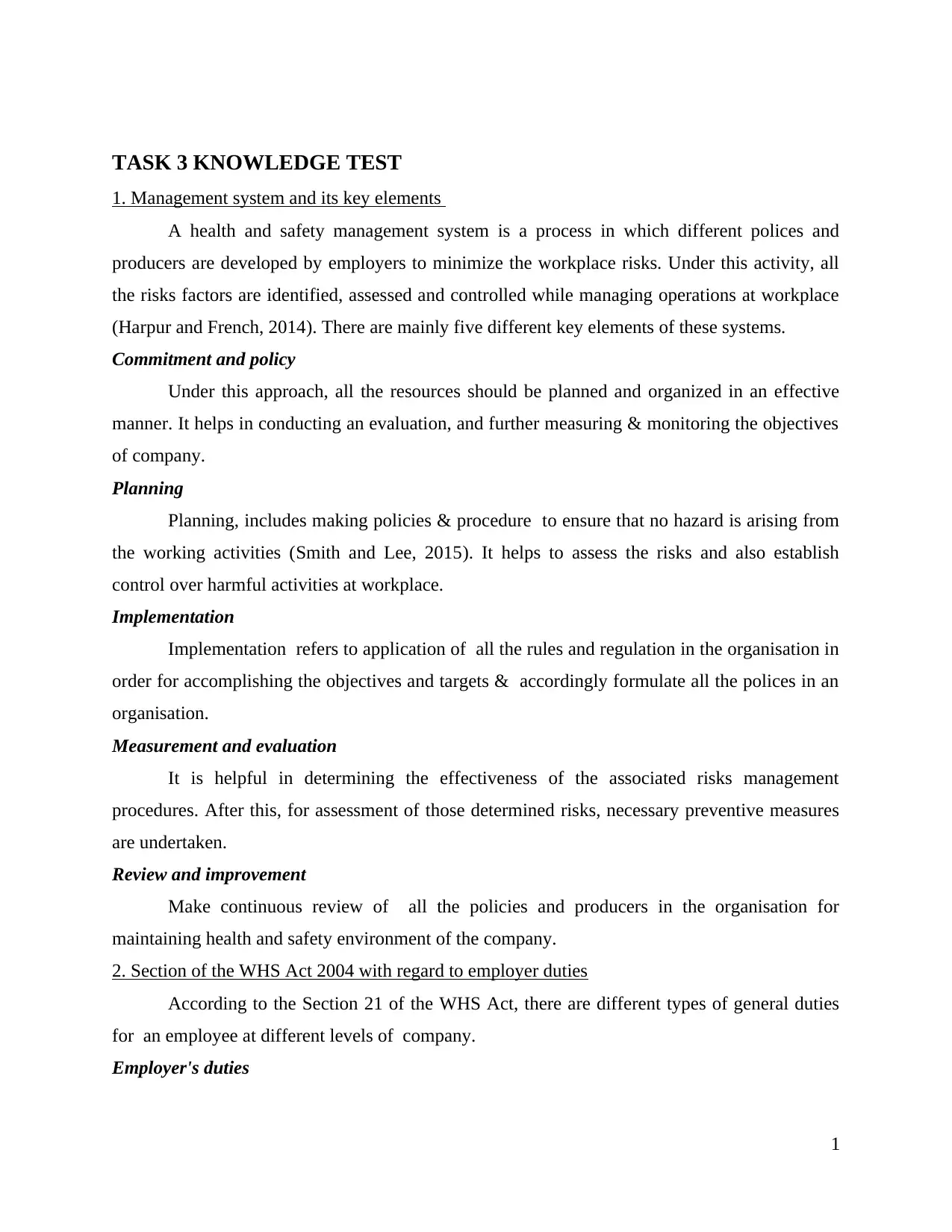
TASK 3 KNOWLEDGE TEST
1. Management system and its key elements
A health and safety management system is a process in which different polices and
producers are developed by employers to minimize the workplace risks. Under this activity, all
the risks factors are identified, assessed and controlled while managing operations at workplace
(Harpur and French, 2014). There are mainly five different key elements of these systems.
Commitment and policy
Under this approach, all the resources should be planned and organized in an effective
manner. It helps in conducting an evaluation, and further measuring & monitoring the objectives
of company.
Planning
Planning, includes making policies & procedure to ensure that no hazard is arising from
the working activities (Smith and Lee, 2015). It helps to assess the risks and also establish
control over harmful activities at workplace.
Implementation
Implementation refers to application of all the rules and regulation in the organisation in
order for accomplishing the objectives and targets & accordingly formulate all the polices in an
organisation.
Measurement and evaluation
It is helpful in determining the effectiveness of the associated risks management
procedures. After this, for assessment of those determined risks, necessary preventive measures
are undertaken.
Review and improvement
Make continuous review of all the policies and producers in the organisation for
maintaining health and safety environment of the company.
2. Section of the WHS Act 2004 with regard to employer duties
According to the Section 21 of the WHS Act, there are different types of general duties
for an employee at different levels of company.
Employer's duties
1
1. Management system and its key elements
A health and safety management system is a process in which different polices and
producers are developed by employers to minimize the workplace risks. Under this activity, all
the risks factors are identified, assessed and controlled while managing operations at workplace
(Harpur and French, 2014). There are mainly five different key elements of these systems.
Commitment and policy
Under this approach, all the resources should be planned and organized in an effective
manner. It helps in conducting an evaluation, and further measuring & monitoring the objectives
of company.
Planning
Planning, includes making policies & procedure to ensure that no hazard is arising from
the working activities (Smith and Lee, 2015). It helps to assess the risks and also establish
control over harmful activities at workplace.
Implementation
Implementation refers to application of all the rules and regulation in the organisation in
order for accomplishing the objectives and targets & accordingly formulate all the polices in an
organisation.
Measurement and evaluation
It is helpful in determining the effectiveness of the associated risks management
procedures. After this, for assessment of those determined risks, necessary preventive measures
are undertaken.
Review and improvement
Make continuous review of all the policies and producers in the organisation for
maintaining health and safety environment of the company.
2. Section of the WHS Act 2004 with regard to employer duties
According to the Section 21 of the WHS Act, there are different types of general duties
for an employee at different levels of company.
Employer's duties
1
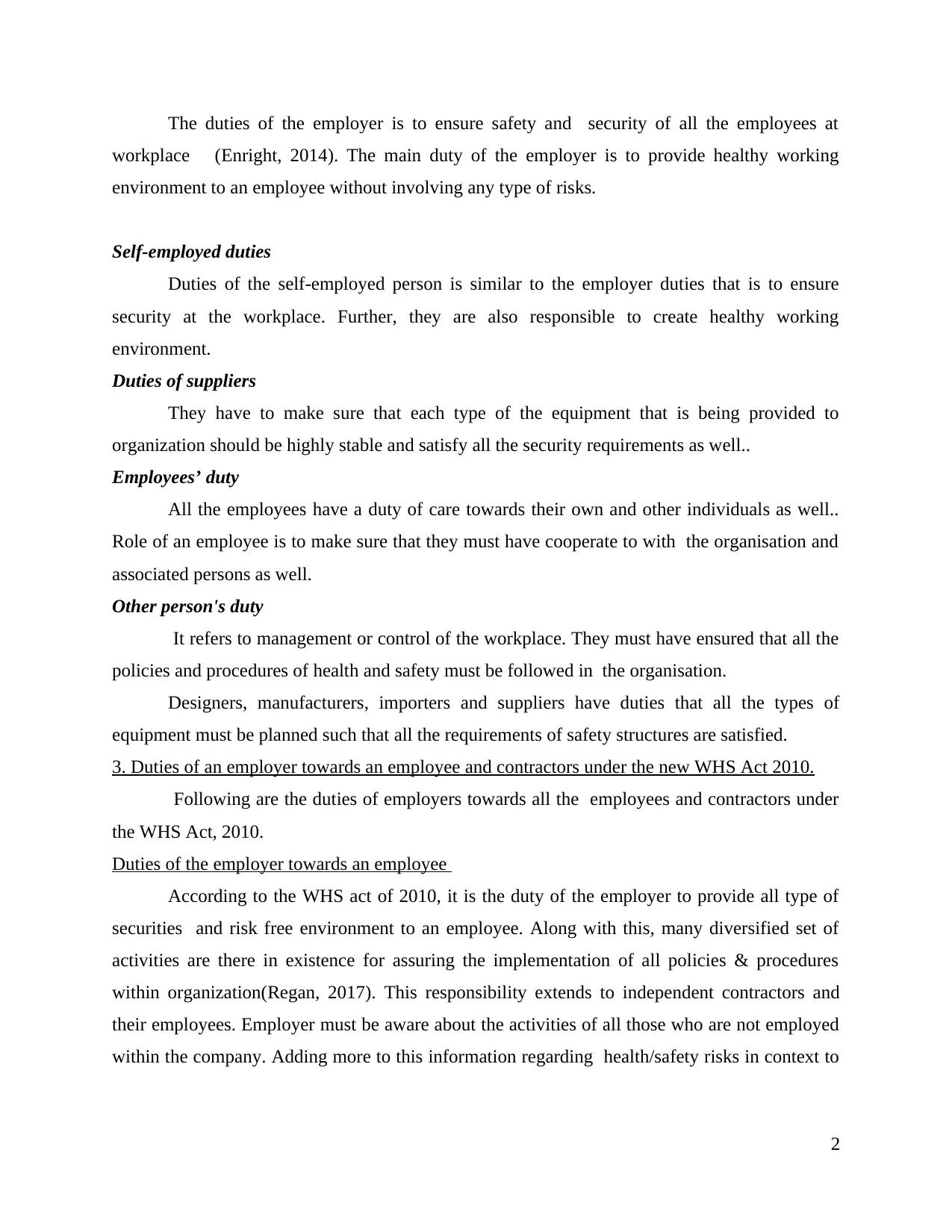
The duties of the employer is to ensure safety and security of all the employees at
workplace (Enright, 2014). The main duty of the employer is to provide healthy working
environment to an employee without involving any type of risks.
Self-employed duties
Duties of the self-employed person is similar to the employer duties that is to ensure
security at the workplace. Further, they are also responsible to create healthy working
environment.
Duties of suppliers
They have to make sure that each type of the equipment that is being provided to
organization should be highly stable and satisfy all the security requirements as well..
Employees’ duty
All the employees have a duty of care towards their own and other individuals as well..
Role of an employee is to make sure that they must have cooperate to with the organisation and
associated persons as well.
Other person's duty
It refers to management or control of the workplace. They must have ensured that all the
policies and procedures of health and safety must be followed in the organisation.
Designers, manufacturers, importers and suppliers have duties that all the types of
equipment must be planned such that all the requirements of safety structures are satisfied.
3. Duties of an employer towards an employee and contractors under the new WHS Act 2010.
Following are the duties of employers towards all the employees and contractors under
the WHS Act, 2010.
Duties of the employer towards an employee
According to the WHS act of 2010, it is the duty of the employer to provide all type of
securities and risk free environment to an employee. Along with this, many diversified set of
activities are there in existence for assuring the implementation of all policies & procedures
within organization(Regan, 2017). This responsibility extends to independent contractors and
their employees. Employer must be aware about the activities of all those who are not employed
within the company. Adding more to this information regarding health/safety risks in context to
2
workplace (Enright, 2014). The main duty of the employer is to provide healthy working
environment to an employee without involving any type of risks.
Self-employed duties
Duties of the self-employed person is similar to the employer duties that is to ensure
security at the workplace. Further, they are also responsible to create healthy working
environment.
Duties of suppliers
They have to make sure that each type of the equipment that is being provided to
organization should be highly stable and satisfy all the security requirements as well..
Employees’ duty
All the employees have a duty of care towards their own and other individuals as well..
Role of an employee is to make sure that they must have cooperate to with the organisation and
associated persons as well.
Other person's duty
It refers to management or control of the workplace. They must have ensured that all the
policies and procedures of health and safety must be followed in the organisation.
Designers, manufacturers, importers and suppliers have duties that all the types of
equipment must be planned such that all the requirements of safety structures are satisfied.
3. Duties of an employer towards an employee and contractors under the new WHS Act 2010.
Following are the duties of employers towards all the employees and contractors under
the WHS Act, 2010.
Duties of the employer towards an employee
According to the WHS act of 2010, it is the duty of the employer to provide all type of
securities and risk free environment to an employee. Along with this, many diversified set of
activities are there in existence for assuring the implementation of all policies & procedures
within organization(Regan, 2017). This responsibility extends to independent contractors and
their employees. Employer must be aware about the activities of all those who are not employed
within the company. Adding more to this information regarding health/safety risks in context to
2
Secure Best Marks with AI Grader
Need help grading? Try our AI Grader for instant feedback on your assignments.
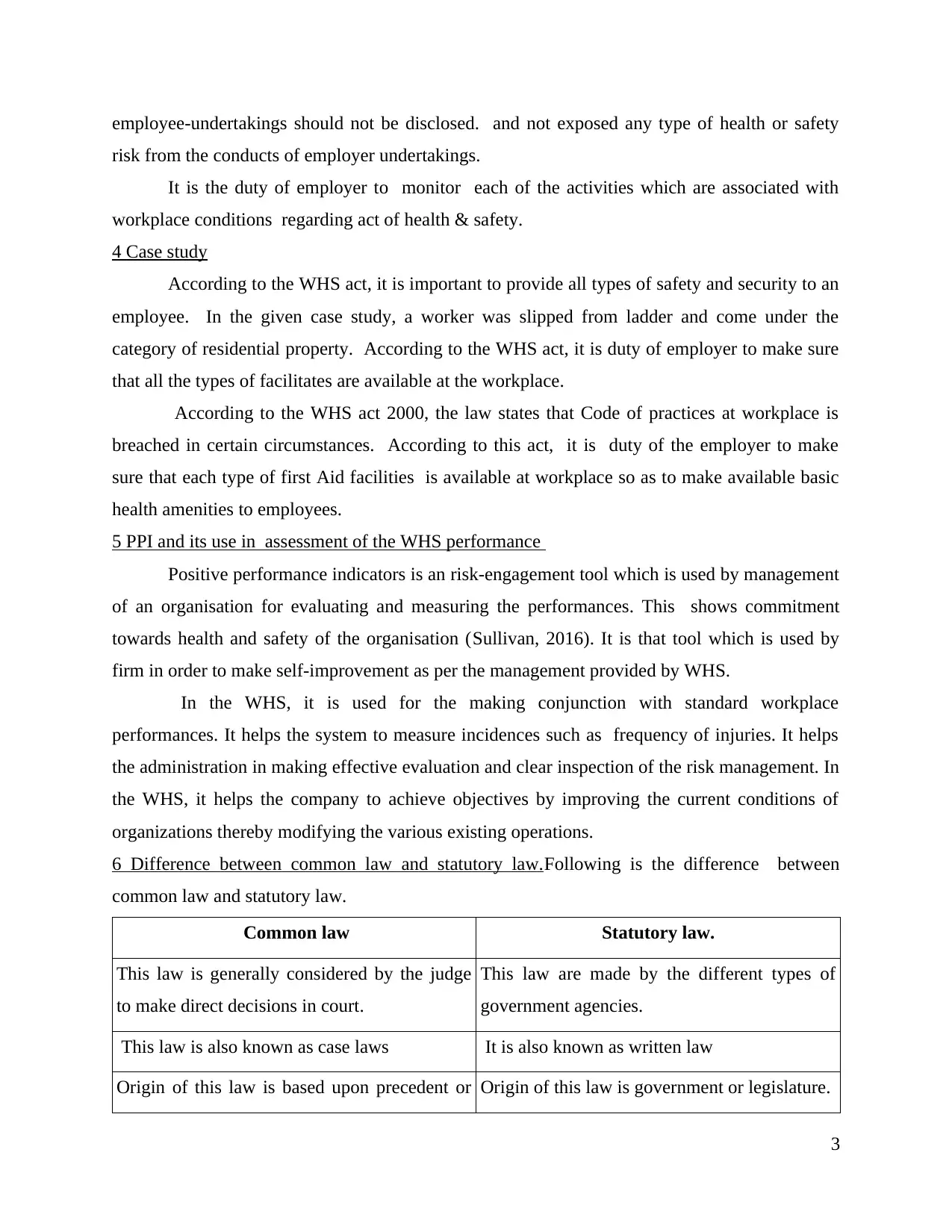
employee-undertakings should not be disclosed. and not exposed any type of health or safety
risk from the conducts of employer undertakings.
It is the duty of employer to monitor each of the activities which are associated with
workplace conditions regarding act of health & safety.
4 Case study
According to the WHS act, it is important to provide all types of safety and security to an
employee. In the given case study, a worker was slipped from ladder and come under the
category of residential property. According to the WHS act, it is duty of employer to make sure
that all the types of facilitates are available at the workplace.
According to the WHS act 2000, the law states that Code of practices at workplace is
breached in certain circumstances. According to this act, it is duty of the employer to make
sure that each type of first Aid facilities is available at workplace so as to make available basic
health amenities to employees.
5 PPI and its use in assessment of the WHS performance
Positive performance indicators is an risk-engagement tool which is used by management
of an organisation for evaluating and measuring the performances. This shows commitment
towards health and safety of the organisation (Sullivan, 2016). It is that tool which is used by
firm in order to make self-improvement as per the management provided by WHS.
In the WHS, it is used for the making conjunction with standard workplace
performances. It helps the system to measure incidences such as frequency of injuries. It helps
the administration in making effective evaluation and clear inspection of the risk management. In
the WHS, it helps the company to achieve objectives by improving the current conditions of
organizations thereby modifying the various existing operations.
6 Difference between common law and statutory law.Following is the difference between
common law and statutory law.
Common law Statutory law.
This law is generally considered by the judge
to make direct decisions in court.
This law are made by the different types of
government agencies.
This law is also known as case laws It is also known as written law
Origin of this law is based upon precedent or Origin of this law is government or legislature.
3
risk from the conducts of employer undertakings.
It is the duty of employer to monitor each of the activities which are associated with
workplace conditions regarding act of health & safety.
4 Case study
According to the WHS act, it is important to provide all types of safety and security to an
employee. In the given case study, a worker was slipped from ladder and come under the
category of residential property. According to the WHS act, it is duty of employer to make sure
that all the types of facilitates are available at the workplace.
According to the WHS act 2000, the law states that Code of practices at workplace is
breached in certain circumstances. According to this act, it is duty of the employer to make
sure that each type of first Aid facilities is available at workplace so as to make available basic
health amenities to employees.
5 PPI and its use in assessment of the WHS performance
Positive performance indicators is an risk-engagement tool which is used by management
of an organisation for evaluating and measuring the performances. This shows commitment
towards health and safety of the organisation (Sullivan, 2016). It is that tool which is used by
firm in order to make self-improvement as per the management provided by WHS.
In the WHS, it is used for the making conjunction with standard workplace
performances. It helps the system to measure incidences such as frequency of injuries. It helps
the administration in making effective evaluation and clear inspection of the risk management. In
the WHS, it helps the company to achieve objectives by improving the current conditions of
organizations thereby modifying the various existing operations.
6 Difference between common law and statutory law.Following is the difference between
common law and statutory law.
Common law Statutory law.
This law is generally considered by the judge
to make direct decisions in court.
This law are made by the different types of
government agencies.
This law is also known as case laws It is also known as written law
Origin of this law is based upon precedent or Origin of this law is government or legislature.
3
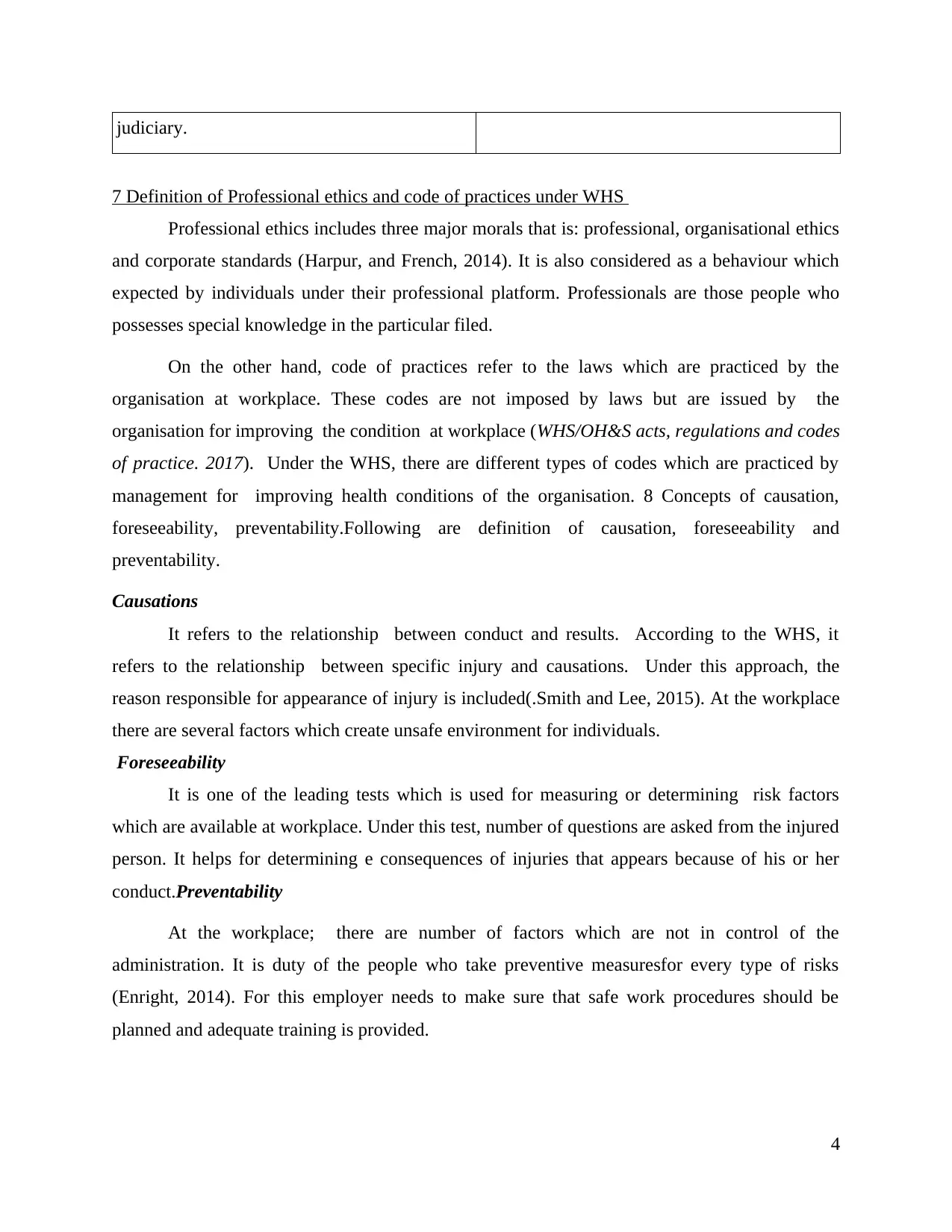
judiciary.
7 Definition of Professional ethics and code of practices under WHS
Professional ethics includes three major morals that is: professional, organisational ethics
and corporate standards (Harpur, and French, 2014). It is also considered as a behaviour which
expected by individuals under their professional platform. Professionals are those people who
possesses special knowledge in the particular filed.
On the other hand, code of practices refer to the laws which are practiced by the
organisation at workplace. These codes are not imposed by laws but are issued by the
organisation for improving the condition at workplace (WHS/OH&S acts, regulations and codes
of practice. 2017). Under the WHS, there are different types of codes which are practiced by
management for improving health conditions of the organisation. 8 Concepts of causation,
foreseeability, preventability.Following are definition of causation, foreseeability and
preventability.
Causations
It refers to the relationship between conduct and results. According to the WHS, it
refers to the relationship between specific injury and causations. Under this approach, the
reason responsible for appearance of injury is included(.Smith and Lee, 2015). At the workplace
there are several factors which create unsafe environment for individuals.
Foreseeability
It is one of the leading tests which is used for measuring or determining risk factors
which are available at workplace. Under this test, number of questions are asked from the injured
person. It helps for determining e consequences of injuries that appears because of his or her
conduct.Preventability
At the workplace; there are number of factors which are not in control of the
administration. It is duty of the people who take preventive measuresfor every type of risks
(Enright, 2014). For this employer needs to make sure that safe work procedures should be
planned and adequate training is provided.
4
7 Definition of Professional ethics and code of practices under WHS
Professional ethics includes three major morals that is: professional, organisational ethics
and corporate standards (Harpur, and French, 2014). It is also considered as a behaviour which
expected by individuals under their professional platform. Professionals are those people who
possesses special knowledge in the particular filed.
On the other hand, code of practices refer to the laws which are practiced by the
organisation at workplace. These codes are not imposed by laws but are issued by the
organisation for improving the condition at workplace (WHS/OH&S acts, regulations and codes
of practice. 2017). Under the WHS, there are different types of codes which are practiced by
management for improving health conditions of the organisation. 8 Concepts of causation,
foreseeability, preventability.Following are definition of causation, foreseeability and
preventability.
Causations
It refers to the relationship between conduct and results. According to the WHS, it
refers to the relationship between specific injury and causations. Under this approach, the
reason responsible for appearance of injury is included(.Smith and Lee, 2015). At the workplace
there are several factors which create unsafe environment for individuals.
Foreseeability
It is one of the leading tests which is used for measuring or determining risk factors
which are available at workplace. Under this test, number of questions are asked from the injured
person. It helps for determining e consequences of injuries that appears because of his or her
conduct.Preventability
At the workplace; there are number of factors which are not in control of the
administration. It is duty of the people who take preventive measuresfor every type of risks
(Enright, 2014). For this employer needs to make sure that safe work procedures should be
planned and adequate training is provided.
4
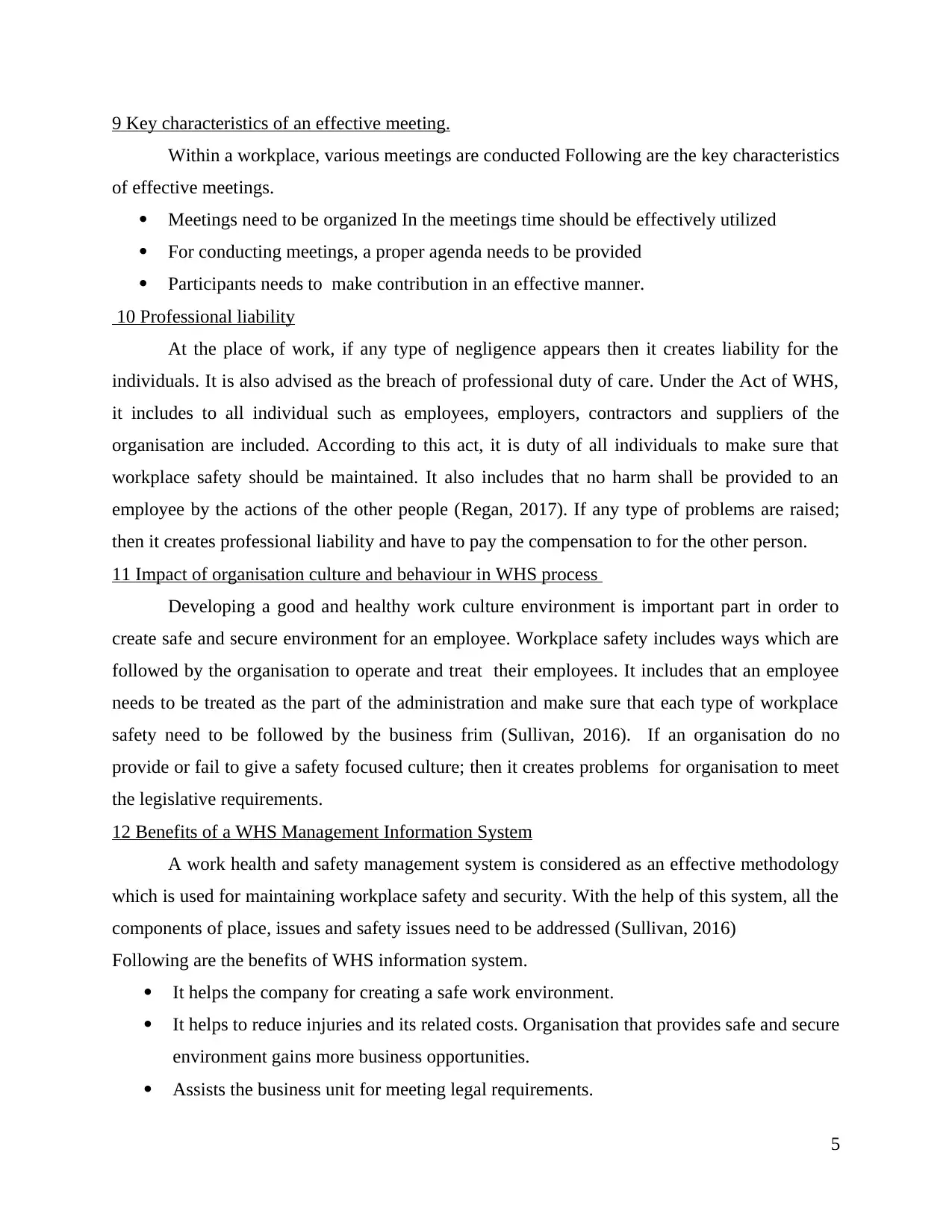
9 Key characteristics of an effective meeting.
Within a workplace, various meetings are conducted Following are the key characteristics
of effective meetings.
Meetings need to be organized In the meetings time should be effectively utilized
For conducting meetings, a proper agenda needs to be provided
Participants needs to make contribution in an effective manner.
10 Professional liability
At the place of work, if any type of negligence appears then it creates liability for the
individuals. It is also advised as the breach of professional duty of care. Under the Act of WHS,
it includes to all individual such as employees, employers, contractors and suppliers of the
organisation are included. According to this act, it is duty of all individuals to make sure that
workplace safety should be maintained. It also includes that no harm shall be provided to an
employee by the actions of the other people (Regan, 2017). If any type of problems are raised;
then it creates professional liability and have to pay the compensation to for the other person.
11 Impact of organisation culture and behaviour in WHS process
Developing a good and healthy work culture environment is important part in order to
create safe and secure environment for an employee. Workplace safety includes ways which are
followed by the organisation to operate and treat their employees. It includes that an employee
needs to be treated as the part of the administration and make sure that each type of workplace
safety need to be followed by the business frim (Sullivan, 2016). If an organisation do no
provide or fail to give a safety focused culture; then it creates problems for organisation to meet
the legislative requirements.
12 Benefits of a WHS Management Information System
A work health and safety management system is considered as an effective methodology
which is used for maintaining workplace safety and security. With the help of this system, all the
components of place, issues and safety issues need to be addressed (Sullivan, 2016)
Following are the benefits of WHS information system.
It helps the company for creating a safe work environment.
It helps to reduce injuries and its related costs. Organisation that provides safe and secure
environment gains more business opportunities.
Assists the business unit for meeting legal requirements.
5
Within a workplace, various meetings are conducted Following are the key characteristics
of effective meetings.
Meetings need to be organized In the meetings time should be effectively utilized
For conducting meetings, a proper agenda needs to be provided
Participants needs to make contribution in an effective manner.
10 Professional liability
At the place of work, if any type of negligence appears then it creates liability for the
individuals. It is also advised as the breach of professional duty of care. Under the Act of WHS,
it includes to all individual such as employees, employers, contractors and suppliers of the
organisation are included. According to this act, it is duty of all individuals to make sure that
workplace safety should be maintained. It also includes that no harm shall be provided to an
employee by the actions of the other people (Regan, 2017). If any type of problems are raised;
then it creates professional liability and have to pay the compensation to for the other person.
11 Impact of organisation culture and behaviour in WHS process
Developing a good and healthy work culture environment is important part in order to
create safe and secure environment for an employee. Workplace safety includes ways which are
followed by the organisation to operate and treat their employees. It includes that an employee
needs to be treated as the part of the administration and make sure that each type of workplace
safety need to be followed by the business frim (Sullivan, 2016). If an organisation do no
provide or fail to give a safety focused culture; then it creates problems for organisation to meet
the legislative requirements.
12 Benefits of a WHS Management Information System
A work health and safety management system is considered as an effective methodology
which is used for maintaining workplace safety and security. With the help of this system, all the
components of place, issues and safety issues need to be addressed (Sullivan, 2016)
Following are the benefits of WHS information system.
It helps the company for creating a safe work environment.
It helps to reduce injuries and its related costs. Organisation that provides safe and secure
environment gains more business opportunities.
Assists the business unit for meeting legal requirements.
5
Paraphrase This Document
Need a fresh take? Get an instant paraphrase of this document with our AI Paraphraser

6
1 out of 8
Related Documents
Your All-in-One AI-Powered Toolkit for Academic Success.
+13062052269
info@desklib.com
Available 24*7 on WhatsApp / Email
![[object Object]](/_next/static/media/star-bottom.7253800d.svg)
Unlock your academic potential
© 2024 | Zucol Services PVT LTD | All rights reserved.




